Trialing deer repellents to control white-tailed deer damage to soybeans
Michigan State University trialed two deer repellents, DeerPro Spring and Summer and DeerPro Ag, to see if they control deer depredation to the point of significantly protecting soybean yield.

Introduction
In areas with high white-tailed deer densities, damage to field crops through feeding, trampling and bedding can reduce harvestable yields. Research from Fritzell et al., 1995, has suggested crop losses to deer greater than 10-15 percent of the total crop or $20 per acre are viewed as significant and require remedy by Michigan producers and hunters. Northeast Lower Michigan has been identified as an area of special concern for white-tailed deer management due to deer population densities well above the Michigan Department of Natural Resources goals and the high prevalence of crop depredation. Damage to soybeans, in particular, has become problematic for growers in the region as production has expanded to approximately 25,000 acres over the last 25 years.
Soybeans are a favorite food of white-tailed deer, meeting their dietary requirements all season long, according to research from Colligan, 2011. Substantial defoliation by deer (greater than 30 percent) prior to the V6 growth stage can significantly reduce soybean yields. On the other hand, mild or passing damage has been shown to increase soybean yield in some cases by stimulating additional branching and pod set. Deer damage is more likely in small fields with a high proportion of forested edge. Michigan State University research conducted in the region during 2015 recorded early season defoliation in soybeans ranging from 0 to 87.5 percent. Deer browsing significantly reduced soybean yields that year. Yield loss at the field scale ranged from 0 to 100 percent, averaging 10 percent or 3.89 bushels per acre.
Chemical repellents are one tool available to growers for controlling wildlife crop damage. They are uncommon in commodity production systems due to the low value and expansive acreage of crops like corn and soybean relative to the high cost of many repellent products. However, repellents may still offer advantages over traditional control options like fencing or shooting. For example, field crop producers are accustomed to controlling pests via chemical means, and using deer repellent spray would therefore be familiar and offer a measure of efficiency. Repellents are also viewed as an ethical alternative to lethal control by some, and could potentially help growers avoid conflict with stakeholders like landlords and neighbors that sometimes oppose lethal controls.
Deer repellants vary greatly in their composition and effectiveness. Repellant products can be classified into two different groups: area repellants and contact repellants. Area repellants are applied on or around the plants desired to be protected, using odors to repel deer. Examples of area repellants considered effective for white-tailed deer are putrescent egg solids, ammonia soaps of higher fatty acids, predator urine, blood or meat meal, human hair, and bar soap. Effectiveness of these products is variable, typically ranging from 15-43 percent effective.
Putrescent egg solids have been used successfully as a deer repellent and included as an active ingredient in several commercial repellent products. Decomposing eggs emit a sulfurous odor that is thought to mimic the smell of predator urine and thus discourage deer from browsing on treated foliage. In one trial from Trent et al., 2001, Deer Away Big Game Repellent powder, containing 36 percent putrescent whole egg solids, outlasted 19 other repellent products, preventing deer damage to Western red cedar seedlings for 15 weeks.
DeerPro Spring and Summer manufactured by Great Oak Inc. of Redding, Connecticut, is another commercial repellent product containing 2.6 percent putrescent egg solids. In a 2016 study by Clemson University, DeerPro significantly reduced deer damage to soybeans relative to an untreated control and other repellent products. In 2017, MSU Extension Presque Isle County trialed a new formulation of DeerPro Spring and Summer with capsaicin added as a means of reducing deer depredation of soybean. That year, the treatment significantly reduced depredation and yield loss at one location, but failed to do so at a second location. We hypothesized at the time that differences in plant date, application dates, row spacing and planting population likely explained the observed differences in efficacy between our two locations, with earlier application near emergence (VE), narrow rows and higher planting population being beneficial.
Contact repellants are applied directly on the plants to be protected using undesirable odors, taste or both odor and taste to repel deer. Common active ingredients in contact deer repellants include benzyldiethyl ammonium saccharide, thiram and capsaisin. Research has shown that contact repellants tend to be more effective than area repellants. However, efficacy of contact repellents is still highly variable according to Hillock et al., 1991, especially across differences in deer pressure and according to the baseline palatability of plant material protected.
DeerPro Ag is a contact repellent product from Great Oak Inc. including the active ingredient thiram (25.8 percent). Thiram is a fungicide, mostly for seed treatment, that has also been used as a conditioned aversion deer repellant. Repellant products containing thiram were shown to be 78 percent effective in protecting yews in one study by Ward and Williams, 2010, and 68 percent effective in protecting arborvitae in another study by Nolte, 1998.
In 2018, MSU Extension trialed a deer repellent package in soybean including an early season application of DeerPro Spring and Summer (putrescent eggs) followed by an application of DeerPro Ag (thiram) three weeks later.
Methods
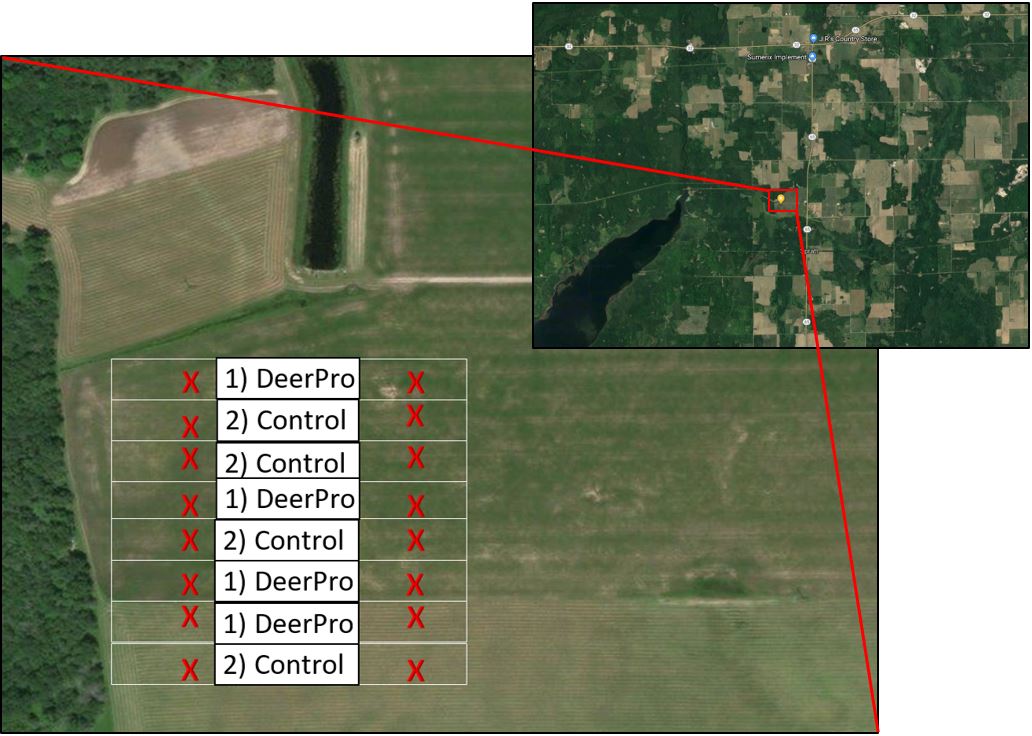
A commercial soybean field in Michigan’s Alpena County (45.019700, -83.758012) was selected for the trial based on landscape factors known to increase the likelihood of deer damage (forested field edges), and a history of significant deer damage as reported by the cooperating grower. The field was 142 acres in size, bordered on three sides by forestland and adjacent to large tracts of woodland maintained for wildlife and hunting. At this site, MG 1.7 soybeans were drilled in 7.5-inch rows at 250,000 seeds per acre on May 24, 2018. Plots 60-feet wide by 300-feet long were established running perpendicular to the west field edge shortly after planting (Figure 1). Two 4-feet by 4-feet by 5-feet tall exclusion cages constructed of steel fence posts and Tenax C flex plastic mesh fencing were placed in each plot, one being 100 feet from the field edge and another 250 feet from the field edge, to measure soybean development and yield potential with zero deer pressure (Figure 2).
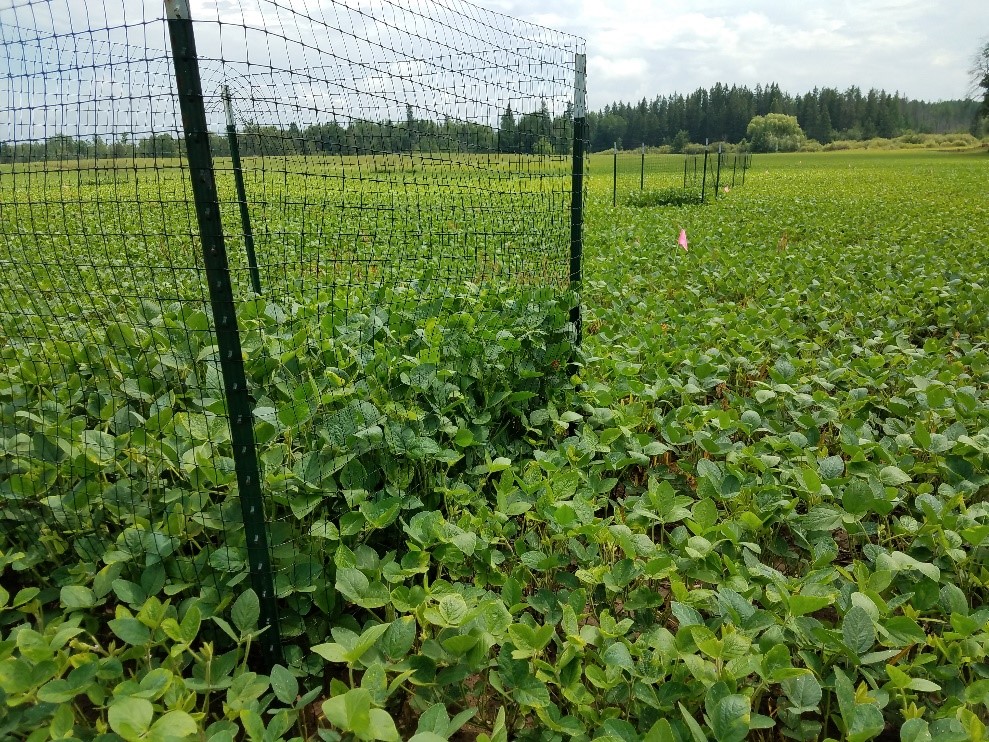
DeerPro and untreated control treatments were randomly assigned and replicated four times for a total of eight plots arranged in a randomized complete block design. DeerPro Spring and Summer was applied at a rate of 1.25 gallons per acre carried in 8.75 gallons of water (10 gallons per acre total rate) using the grower’s self-propelled sprayer on June 7 at the unifoliate leaf stage (VC) (Figure 3). DeerPro Ag was applied at a rate of 1.45 gallons per acre carried in 8.55 gallons of water (10 gallons per acre total rate) using the grower’s self-propelled sprayer on June 29t at the four-leaf stage (V4). Both repellent applications were made within two days of, but separate from, Liberty herbicide applications for weed control. Trail cameras with motion activated triggers were placed at the edge of each plot on June 20 to monitor how many deer were present and actively feeding.
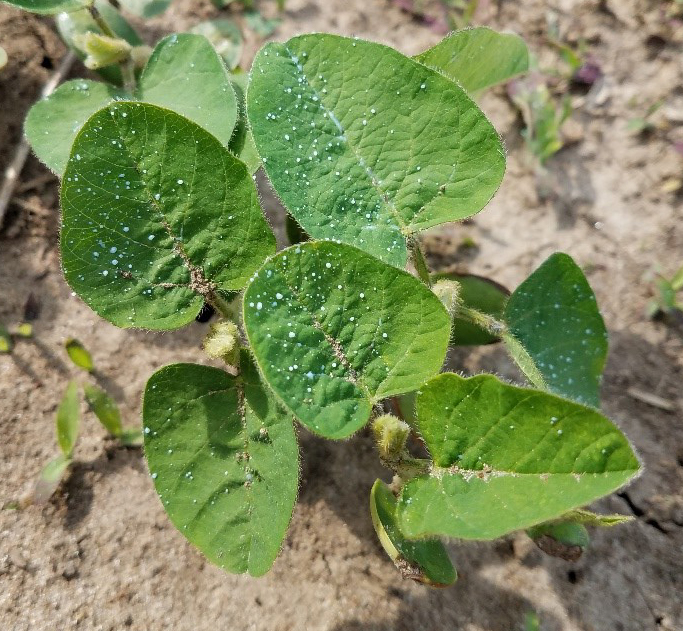
Deer damage was monitored from V1 until the V6/R1 growth stage, after which damage is thought to be less detrimental to yield. Our primary method was hand counting the number of plants damaged and percent defoliation relative to undamaged plants in 17.4 feet of row (1/2,000 of an acre) at four random locations per plot about every 10 days. Counting began June 13 and continued for six weeks.
At crop maturity, two methods were used to measure soybean yield on Oct. 24. The first method was to harvest soybeans within each exclusion cage. Beans were hand harvested from the cages, threshed using a stationary plot thresher and weighed. After the exclusion samples were harvested and cages removed, a strip was harvested from each plot using the cooperating grower’s combine (40 feet by 300 feet) and weighed using a weigh wagon to determine average plot yield. All yield data was adjusted for grain moisture at harvest.
Results and discussion
Deer numbers observed per plot per day in trail camera photos were low and not significantly different between treatments until five days after Treatment Two using thiram (DAT2), when deer numbers appeared to increase dramatically in treated plots and remained significantly higher (P < 0.10) than deer numbers observed in control plots through 26 DAT2, when monitoring was discontinued (Figure 4). Our DeerPro repellent treatments significantly reduced soybean defoliation by 19 and 17 percent respectively at 13 and 23 days after Treatment One using putrescent egg solids (DAT1), and by 7 percent at four DAT2 using thiram (P < 0.10) (Figure 5).
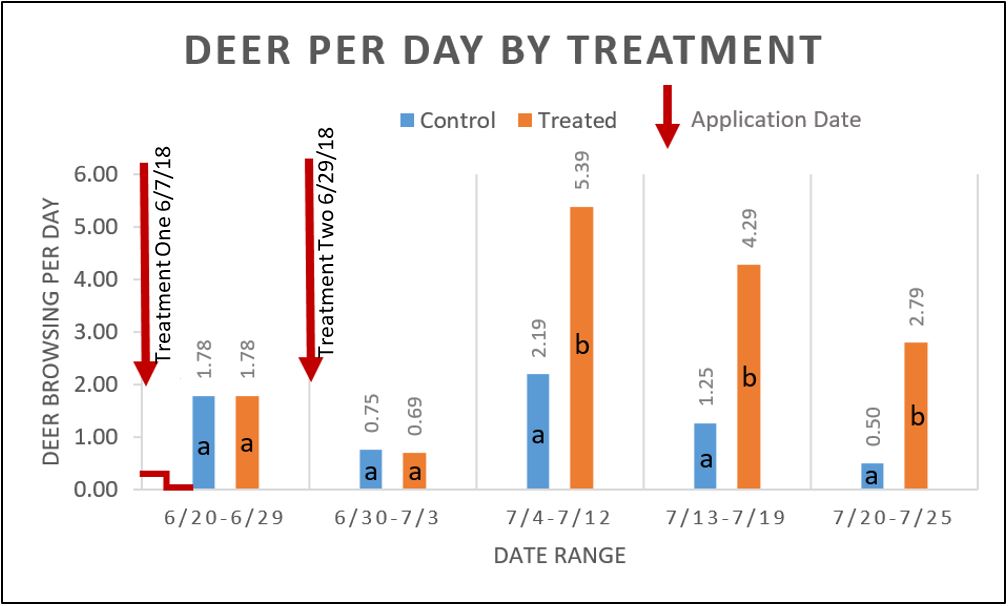
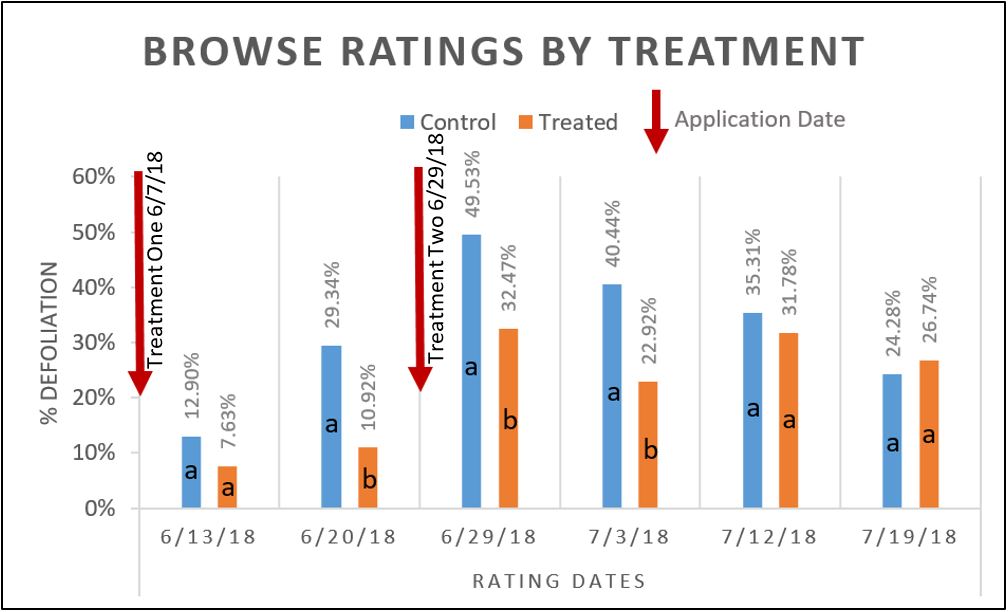
However, defoliation was not significantly different between the treatments beyond four DAT2 due to both a decrease in browsing of control plots (or plant growth outpacing damage) and the increase in deer observed browsing in treated plots beyond four DAT2. Soybean yield was not significantly different between treatments within the exclosure cages or in the exposed plots. The difference in soybean yield between exclosure cages and exposed areas within individual plots was also not significantly different between treatments (Figure 6).
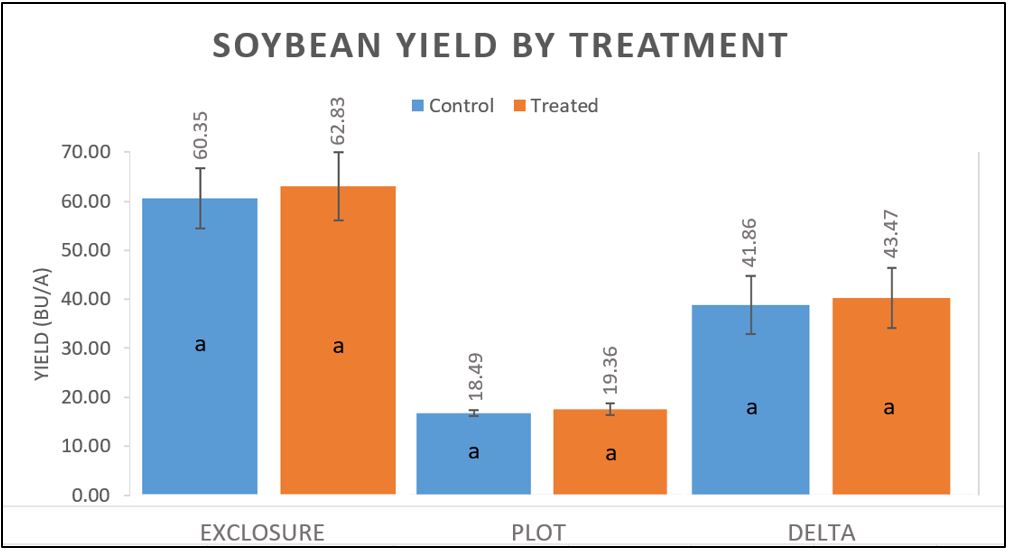
Our data suggest the DeerPro repellent package tested was not able to control deer depredation to the point of significantly protecting soybean yield. Treatment One using putrescent egg solids was more successful, reducing deer browsing significantly for three weeks after treatment. Treatment Two using thiram moderately suppressed browsing for less than one week. In fact, deer were more abundant, or spent more time, in treated plots beginning four or five days after Treatment Two.
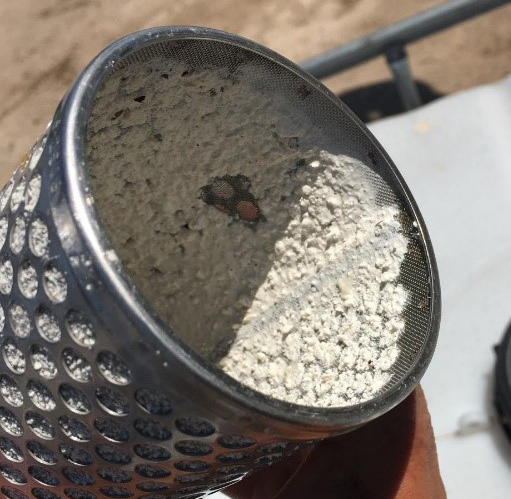
We hypothesize that thiram, as a contact repellent, protected plants only long enough to produce one new trifoliate leaf per plant, at which point deer descended on the treated plots to eat the unprotected new growth. This contrasts with our observations of deer browsing in soybean treated with putrescent eggs. As an area repellent, putrescent egg appears to truly protect a wide area beyond treated plant tissue or soil, both in terms of new untreated growth on individual plants, and across adjoining treated-untreated plots via edge effect inherent in our study design. Thriam showed some efficacy and did not appear to be phytotoxic or yield limiting. However, it was difficult to apply due to clogging of spray equipment, and the application rate or coverage could have been compromised in the process (Figure 7).
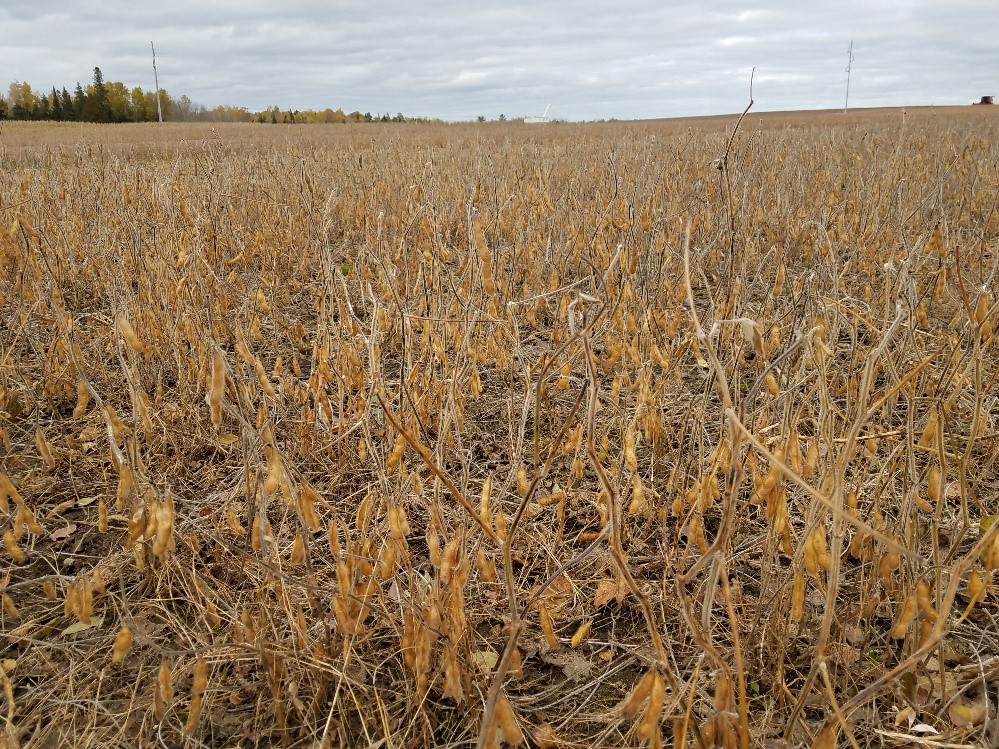
It is important to note that a great deal of late-season pod feeding was observed across our trial, confounding damage that one would not expect to be effected by an early-season repellent application to vegetative tissue (Figure 8). Despite this limitation, we conclude that DeerPro Spring and Summer repellent containing putrescent eggs solids is likely a more effective deer repellent option than thiram for use in soybean.
Special thanks to Great Oak Inc. for supporting this research, and the Brandt family for their time and effort in conducting the trial.
References
- Braun, K. 1996. Ecological factors influencing white-tailed deer damage to agricultural crops in northern lower Michigan. M.S. Thesis. MSU Department of Fisheries and Wildlife
- Campa, H., III, S. R. Winterstein, R. B. Peyton, G. Dudderar, and L. A. Leefers. 1997. An evaluation of a multidisciplinary problem: Ecological and sociological factors influencing white-tailed deer damage to agricultural crops in Michigan. Transactions of the North American Wildlife and Natural Resource Conference 62:431-440.
- Colligan, G.M., Bowman, J.L., Rogerson, J.E. and B.L. Vasilas. 2011. Factors affecting white-tailed deer browsing rates on early growth stages of soybean crops. Human–Wildlife Interactions 5(2):321–332.
- Conover, M. R., and D.J. Decker. 1991. Wildlife damage to crops; perceptions of agricultural and wildlife professionals in 1957 and 1987. Wildl. Soc. Bull. 19:46-52.
- DeDecker, J. and C. Tollini. 2016. Study finds 10 percent of 2015 soybean yield lost to white-tailed deer in Presque Isle County. Michigan State University Extension.
- DeDecker, J. and C. Tollini. 2018. Trialing DeerPro Spring & Summer repellent to control white-tailed deer depredation of soybeans. Michigan State University Extension.
- Fritzell, P.A., Minnis, D.L. and R.B. Peyton. 1995. A comparison of deer hunter and farmer attitudes about crop damage abatement in Michigan: Messages for hunters, farmers and managers. Proceedings of the Seventh Eastern Wildlife Damage Management Conference.
- Fritzell, P., Dudderar, G. and R.B. Peyton. 1997. An Evaluation of Farmer Applications of Deer Damage Controls. Proceedings of the Eighth Eastern Wildlife Damage Management Conference
- Garrison, R.L. and J.C. Lewis. 1987. Effects of Browsing by White-Tailed Deer on Yields of Soybeans. Wildlife Society Bulletin,Vol. 15, No. 4. pp. 555-559
- 2010. Michigan Deer Management Plan. Michigan Department of Natural Resources and Environment. Wildlife Division Report No. 3512
- Rogerson, J., Bowman, J., Tymkiw, E., Colligan, G. and B. Vasilas. 2014. The Impacts of White-Tailed Deer Browsing and Distance From the Forest Edge on Soybean Yield. Wildlife Society Bulletin 38(3):473–479.
- Trent, A., Nolte, D. and K. Wagner. 2001. Comparison of Commercial Deer Repellents. USDA National Wildlife Research Center – Staff Publications #572.



 Print
Print Email
Email




